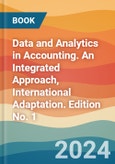Data Analytics in Accounting: An Integrated Approach develops an integrated data analysis and critical thinking skill set needed to be successful in the rapidly changing accounting profession. Following a pattern-based approach to profiling, cleaning, and transforming data, the book helps explore data from a variety of perspectives for analytical purposes and key data relationships. The text guides students to develop the professional skills they need to plan, perform, and communicate data analyses effectively and efficiently in the real world.
This international edition introduces a new feature “Data Analytics and Decision Making” at the end of the book, which offers students the opportunity to see how they can use data analytics to help solve realistic business problems. In addition, topical changes have been made in select chapters and brief exercises along with multiple-choice questions have been revised in all the chapters.Table of Contents
Plan
1. Data and Analytics in the Accounting Profession 1
2. Foundational Data Analysis Skills 41
3. Motivations and Objectives for Data Analysis 109
4. Planning Data and Analysis Strategies 171
Analyze
5. Analysis: Data Preparation 229
6. Analysis: Information Modeling 299
7. Analysis: Data Exploration 363
Report
8. Interpreting Data Analysis Results 423
9. Communicating Data Analysis Results 483
10. Recent Data and Analyses Developments in Accounting 543
Data Analytics and Decision-making Da- 1
Glossary G- 1
Index I- 1








